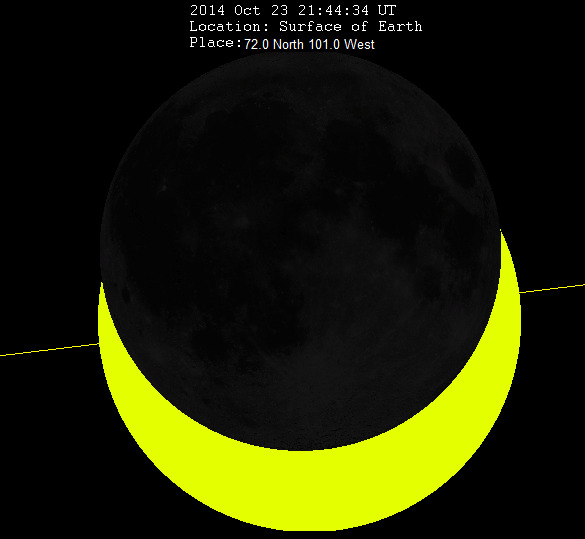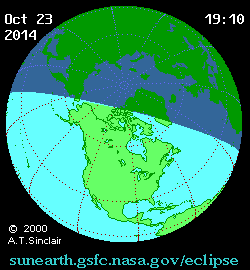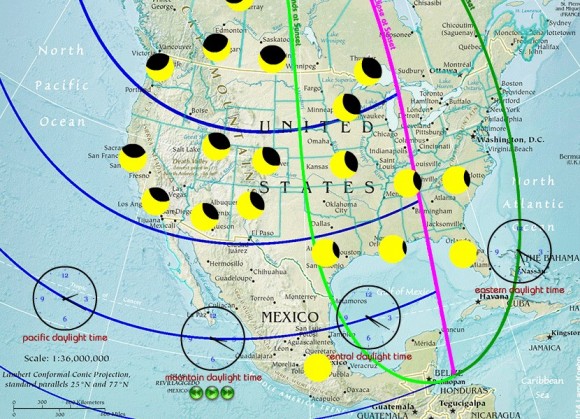Results 1 to 2 of 2
Thread: Solar Eclipse
Thread Information
Users Browsing this Thread
There are currently 1 users browsing this thread. (0 members and 1 guests)
-
10-23-2014, 07:37 AM #1Banned

- Join Date
- Jun 2013
- Posts
- 8,546
-
10-23-2014, 08:28 AM #2working4changeGuest
Partial solar eclipse for North America on October 23

Solar_eclipse_of_October_23_2014_greatest_partiali ty
What you see above is a simulation of the October 23, 2014 solar eclipse – at greatest eclipse (5:44 p.m. EDT) – from the vantage point of Canada’s Nunavut Territory near Prince of Wales Island. Notice that it is a partial eclipse. At greatest eclipse, from this prime location, the solar disk is 75% covered over by the moon. Everyplace else within the eclipse viewing area sees a shallower partial solar eclipse on October 23. You can watch the event online, right here, on the player below. It will convert to a live player when the show begins. The free, real-time view of the eclipse starts at 21:00 UTC (2 p.m. PDT / 4 p.m. CDT/ 5 p.m. EDT). EarthSky’s own Deborah Byrd will be joining the show at 22:20 UTC (5:20 CDT).
Convert UTC to your time zone
If you want to watch the eclipse directly, eye safety is of the utmost importance. That said, North America has a ringside seat to the partial eclipse of the sun on October 23. This eclipse is almost exclusively visible on land from North America. Click on the links below to find out about the partial solar eclipse on October 23, which primarily takes place during the afternoon hours in North America.
Eclipse times for North American Time Zones
Eclipse calculators give eclipse times for your sky
What causes a solar eclipse?
Observing solar eclipses safely

Find out if an astronomy club or observatory near you is hosting a public viewing of this eclipse.
The partial solar eclipse can be viewed as far north as the Arctic and as far south as Mexico. It can be seen as far east as the American East Coast and as far west as the American West Coast, and much of the Pacific Ocean to the north of Hawaii. Image credit: NASA Web Site Page
The partial solar eclipse can be viewed as far north as the Arctic and as far south as Mexico. It can be seen as far east as the American East Coast and as far west as the American West Coast, and much of the Pacific Ocean to the north of Hawaii. Image credit: NASA Web Site Page
Animation showing the moon's penumbral shadow sweeping from west to east across the Earth's surface on October 23, 2014.

Animation showing the moon’s penumbral shadow sweeping from west to east across the Earth’s surface on October 23, 2014.
Eclipse times for North American time zones
We list the eclipse times for certain localities at North American time zones in local time. However, the eclipse times will vary somewhat even within the same time zone. An expanded list of local eclipse times are available for US cities or Canadian and Mexican cities. All times are in local time, so no conversion is necessary!
Eastern Daylight Time
Philadelphia, Pennsylvania
Solar eclipse begins: 17:51 (5:51 p.m.) EDT
Greatest Eclipse: 18:08 (6:08 p.m.) EDT
Sunset before end of eclipse
Maximum obscuration of solar disk: 10%
Central Daylight Time
St. Louis, Missouri
Solar eclipse begins: 16:41 (4:41 p.m.) CDT
Greatest eclipse: 17:47 (5:47 p.m.) CDT
Sunset before end of eclipse
Maximum obscuration of solar disk: 39%
Mountain Daylight Time
Denver, Colorado
Solar eclipse begins: 15:18 (3:18 p.m.) MDT
Greatest eclipse: 16:35 (4:35 p.m.) MDT
Solar eclipse ends: 17:44 (5:44 p.m.) MDT
Maximum obscuration of solar disk: 45%
Pacific Daylight Time
San Francisco, California
Solar eclipse begins: 13:52 (1:52 p.m.) PDT
Greatest eclipse: 16:35 (4:35 p.m.) PDT
Solar eclipse ends: 17:44 (5:44 p.m.) PDT
Maximum obscuration of solar disk: 39%
Alaska Daylight Time

Anchorage, Alaska
Solar eclipse begins: 11:55 a.m. AKDT
Greatest eclipse: 13:11 (1:11 p.m.) AKDT
Solar eclipse ends: 14:28 (2:28 p.m.) AKDT
Maximum obscuration of solar disk: 55%
October 23, 2014 solar eclipse via shadowsandsubstance.com

October 23, 2014 solar eclipse via shadowsandsubstance.com
Many saw dancing illuminated crescents like these, created when the leaves of trees and bushes acted as pinhole cameras and projected the eclipsed sun's image onto cars and buildings. This photo from Chris Walker in Dayton, Nevada.
If the eclipse is deep enough in your area, it’s possible you’ll see dancing illuminated crescents, created when the leaves of trees and bushes acted as pinhole cameras and projected the eclipsed sun’s image onto cars and buildings. This photo from Chris Walker in Dayton, Nevada, who captured a May 2012 partial solar eclipse.
Eclipse calculators gives eclipse times for your sky
We present two eclipse calculators, enabling you to find out eclipse times in your sky. Timeanddate.com gives the eclipse times in your local time, so no conversion is necessary. The US Naval observatory lists the eclipse times in Universal Time, so you must convert Universal Time to your local clock time. Subtract 4 hours for EDT, 5 hours for CDT, 6 hours for MDT and 7 hours for PDT.
Eclipse calculator courtesy of timeanddate.com
Eclipse computer courtesy of the US Naval Observatory
How do I convert Universal Time into my time?

When the new moon very closely aligns with one of its nodes, the moon's dark umbral shadow falls on Earth, presenting a total eclipse of the sun. However, the alignment is too inexact for the moon's umbral shadow to fall on Earth on October 23, so only the penumbral shadow hits Earth, to feature a partial lunar eclipse. Image credit: Wikipedia
When the new moon very closely aligns with one of its nodes, the moon’s dark umbral shadow falls on Earth, presenting a total eclipse of the sun. However, the alignment is too inexact for the moon’s umbral shadow to fall on Earth on October 23, so only the penumbral shadow hits Earth, to feature a partial lunar eclipse. Image credit: Wikipedia
What causes a solar eclipse?
A lunar eclipse happens whenever the new moon passes in front of the sun, and the moon’s shadow falls on our planet. A solar eclipse is only possible at new moon because that’s the only time whereby the moon to go in front of the sun, as seen from Earth. Most of the time, however, the new moon either swings north or south of the solar disk, so no eclipse of the sun takes place.
The plane of the moon’s orbit around Earth is inclined at 5o to the plane of the Earth’s orbit around the sun. For half the month, the moon orbits Earth to the north of the ecliptic (Earth’s orbital plane); and for the other half of the month, the moon orbits Earth to the south of the ecliptic (Earth’s orbital plane). Twice a month, however, the moon crosses the Earth’s orbital plane at points called nodes. If the moon is traveling from north to south, it’s called a descending node, and when it’s going from south to north, it’s called an ascending node.
When a new moon happens as the moon is at or near one of its nodes, a solar eclipse is not only possible – but inevitable. It’s far from a perfect alignment this time around, though, as the moon reaches its ascending node about 21 hours before the moon turns new. Thereby, the moon’s dark umbral shadow misses Earth completely, falling some 675 kilometers (420) miles above the Earth’s surface. Although no total solar eclipse can be seen from Earth, the new moon happens close enough to its ascending node for the moon’s penumbral shadow to fall on Earth and for a partial solar eclipse to take place at northerly latitudes.
Bottom line: North America will have a ringside seat to the partial eclipse of the sun on October 23, 2014. Eclipse times and more in this post.
Bruce McClure
http://earthsky.org/tonight/partial-...-on-october-23
Similar Threads
-
BLM Seeks Public Interest for Solar Energy Development in Dry Lake Solar Energy Zone
By JohnDoe2 in forum Other Topics News and IssuesReplies: 4Last Post: 04-16-2014, 12:08 AM -
Recalling The Start Of America’s Fiscal Eclipse
By AirborneSapper7 in forum Other Topics News and IssuesReplies: 0Last Post: 01-08-2013, 01:32 AM -
U.S. Solar Panel Market Doubles as First Solar Looks to Brighter 2012
By JohnDoe2 in forum Other Topics News and IssuesReplies: 0Last Post: 03-17-2012, 12:37 AM -
Full Lunar Eclipse going on right now!
By ALIPAC in forum Other Topics News and IssuesReplies: 5Last Post: 02-21-2008, 01:24 AM -
Total Lunar Eclipse Expected Saturday
By CCUSA in forum Other Topics News and IssuesReplies: 0Last Post: 03-02-2007, 12:46 PM


 LinkBack URL
LinkBack URL About LinkBacks
About LinkBacks





 Reply With Quote
Reply With Quote


Ukraine-Israel Bill Secretly Funds Biden's invasion!
04-24-2024, 12:01 PM in illegal immigration Announcements